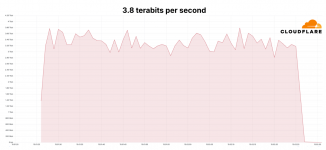In a digital landscape increasingly fraught with cyber threats, a recent distributed denial-of-service (DDoS) attack has set a new record, pushing the boundaries of what cybersecurity experts once thought possible. Cloudflare, a web infrastructure and security company, recently disclosed that it successfully mitigated an unprecedented DDoS attack that peaked at a staggering 3.8 terabits per second (Tbps).
The Assault: A New Benchmark in Cyber Warfare
The attack, which lasted for 65 seconds, was part of a larger campaign that has been ongoing since early September 2024. Cloudflare reported fending off "over one hundred hyper-volumetric L3/4 DDoS attacks throughout last month, with many exceeding 2 billion packets per second (Bpps) and 3 terabits per second (Tbps)."
This series of attacks targeted a diverse range of sectors, including financial services, internet infrastructure, and telecommunications. The sheer scale of these assaults surpasses the previous record set in November 2021, which peaked at 3.47 Tbps and targeted a Microsoft Azure customer in Asia.
The Anatomy of a Record-Breaking Attack
The attacks leveraged the User Datagram Protocol (UDP) on a fixed port, with the flood of malicious traffic originating from multiple countries, including Vietnam, Russia, Brazil, Spain, and the United States. The compromised devices forming this massive botnet included MikroTik devices, DVRs, and web servers.
Of particular concern is the involvement of a large number of infected ASUS home routers. These devices were likely exploited using a recently disclosed critical vulnerability (CVE-2024-3080), which affected over 157,000 ASUS router models as of June 2024.
The Ripple Effect: Industries Under Siege
The banking and financial services sectors, along with public utilities, have seen a significant uptick in DDoS attacks. According to NETSCOUT, a network performance monitoring company, these industries have experienced a 55% increase in such attacks over the past four years. The first half of 2024 alone saw a 30% rise in volumetric attacks.
This surge is attributed in part to heightened hacktivist activities targeting global organizations. Adding to the complexity, attackers are increasingly using DNS-over-HTTPS (DoH) for command-and-control operations, making detection more challenging.
The Defensive Line: Strategies and Challenges
Cloudflare emphasized the importance of efficient packet inspection and disposal to defend against high packet rate attacks. "To defend against high packet rate attacks, you need to be able to inspect and discard the bad packets using as few CPU cycles as possible, leaving enough CPU to process the good packets," the company stated.
However, the sheer scale of these attacks poses significant challenges. Many cloud services with insufficient capacity, as well as on-premise equipment, struggle to defend against DDoS attacks of this magnitude. The high bandwidth utilization can clog internet links, while the high packet rate can overwhelm in-line appliances.
A Shifting Landscape: New Vulnerabilities Emerge
As if the current threat landscape wasn't challenging enough, researchers have identified new potential vectors for DDoS attacks. Akamai recently revealed that vulnerabilities in the Common UNIX Printing System (CUPS) in Linux could be exploited to mount DDoS attacks with a 600x amplification factor in mere seconds.
This vulnerability affects over 58,000 devices accessible on the public internet, potentially creating a vast pool of resources for future attacks.
The Road Ahead: Vigilance and Innovation
As the scale and sophistication of DDoS attacks continue to grow, the cybersecurity community faces an ongoing challenge to stay ahead of threat actors. The record-breaking attack mitigated by Cloudflare serves as a stark reminder of the ever-evolving nature of cyber threats.
Organizations are advised to remain vigilant, regularly update their systems, and consider removing unnecessary services that could be exploited. As we move forward, the ability to rapidly detect, mitigate, and adapt to new attack vectors will be crucial in maintaining the integrity and availability of digital services in an increasingly connected world.
In conclusion, while this record-breaking attack demonstrates the growing capabilities of malicious actors, it also highlights the resilience and adaptability of modern cybersecurity measures. As the battle between attackers and defenders continues, the incident serves as a catalyst for further innovation in the field of network security.


